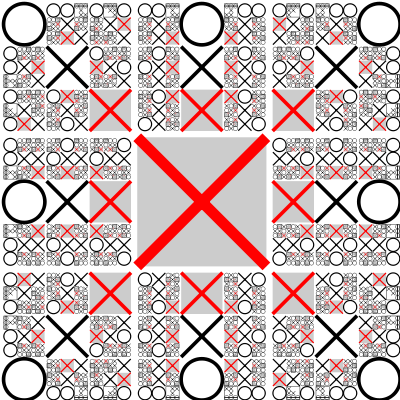The ratio of the depth to complexity of a game system. The "efficiency" of the design.
Elegance is a term that can elicit groans from game designers and reviewers alike when it is invoked. It is thrown around often, and with many different meanings in discussions about mechanical systems. It is often conflated with the subjective quality of a game's systems or sometimes with their simplicity. This scattershot use of the term means that some people view it as an empty piece of praise or a relatively meaningless descriptor. However, the term has a distinct and meaningful use as outlined Cameron Browne's paper from 2012, and it's a definition of which I think most people actually have a vague or intuitive idea, even if they couldn't define it when prompted.
The elegance of a system is the ratio of the complexity of that system to the depth that it produces. A system with a high depth and low complexity is said to be "elegant," though where this line lies is entirely subjective. But to really understand what this definition is saying, first we need to define both complexity and depth.
Complexity
Complexity seems the more straightforward of the two terms at first. It might seem like an objective state of the system we can quantify: a measure of the total scope an intricacy of all the mechanics in the system. However, this is only part of the equation. The dynamics that emerge from the interactions of these mechanics can create wildly complex interactions. Think about how a small number of relatively-simple cards in Magic: the Gathering can interact in ways that require experienced judges to come in a mediate at tournaments. In this way, a collection of simple mechanics can create a set of wildly complex interactions.
Now, some of this emergent complexity is good! As we'll get into with depth, these kind of complex interactions are exactly what creates deep game experiences. So how do we distinguish how much an interactions adds to the complexity of the system, versus adds to the depth of a system? The meaningful distinction here is what interactions the player needs to understand to be able to play the game, not necessarily to play the game perfectly (or even well), just to play it to completion. Looking back to our initial mention of mechanics then, we can apply this distinction there as well: only mechanics the the player needs to understand to be able to play the game add to complexity (for its relevance to elegance at least).
Finally, bringing these two elements together we can define the complexity of a system as the difficulty for a player to understand all the rules and interactions needed to play the game to completion.
Depth
The depth of the game system is, put simply, the possibility space of all of that complexity interacting in play. It is all the ways that the pieces of the system can interact to create meaningfully different outcomes, meaningfully different decisions for the players, or meaningfully different experiences.
As you might be able to guess from its use three times in a row, the phrase "meaningfully different" is important here. You can create a system that generates, on paper, an infinite number of different outcomes, but if those all feel relatively similar to the player, the number is irrelevant. My favorite illustration of this is Kate Compton's "10,000 bowls of oatmeal problem" in her article on procedural generation:
I can easily generate 10,000 bowls of plain oatmeal, with each oat being in a different position and different orientation, and mathematically speaking they will all be completely unique. But the user will likely just see a lot of oatmeal.
If a system creates 10,000 different outcomes, it's important that players can perceive those differences.
When covering complexity above, we discussed how the dynamics that a player needs to understand to be able to play the game contribute to complexity. This does not mean that all the other dynamics that make up the depth of the system shouldn't be understood by a player, merely that they don't need to be to play the game at first. One of the beautiful things about a deep system is that players are constantly learning and and discovering new aspects of the interactions, improving their abilities and being surprised by a game. When it comes to some of the most deep, elegant games in the world like Go and Chess, players can spend their entire lives exploring the depth of those games.
Elegance in Games
Now that we have a functional definition for depth, complexity, and elegance let's take a look at some practical examples. The most straightforward examples, mentioned above, are combinatorial games like Go and Chess. These games have a small, fixed set of known rules that interact in incredibly deep ways. They are incontrovertibly elegant games whose depth many players spend entire careers exploring.
Examples of the other extreme, games with very high complexity yet low depth, are harder to come by. High complexity can create a barrier to entry, and if there isn't depth on the other side, players don't take the time to overcome that barrier. So games like this don’t often excel. I think the example I've settled on for this category is Warhammer 40k (don't @ me, I'm actually an avid player). This miniatures game has hundreds of pages of necessary rules across its rulebooks and codices specific to each army. Games play out over the course of four hours where dozens of units each have dozens of rules all interacting with each other. This ends to create an experience that, while it has some pockets of depth, does not have a depth commiserate to the complexity it offers. The game instead exists on what it offers from a storytelling and creative hobbying perspective. Being a system to simulate massive, gorgeous dioramas. That still has value, but isn't the mechanical depth we're discussing and charting today.
Most games don't fall into either of these extremes, however. Most games sit somewhere in the middle with closer to what we'll call a "1:1" complexity-to-depth ratio. Where exactly one game's elegance compares to another is a question left to arguments across social media, but I'd like to use this metric to discuss one other phenomenon we see in the modern games industry: live games.
In addition to the marketing value live games bring, we can use this model of elegance to look at the value that games with "content treadmills" bring to the players. Games like League of Legends or Magic the Gathering, for example, are both fairly elegant games at their core. But even the extent of their depth would probably not be enough to sustain a large community's interest across decades. Think about if Magic only had the alpha set, or if League only had its starting champions. Players would have likely moved on years ago. Instead, by constantly releasing new content (new complexity), these games incrementally increase the depth of their game, giving new possibility space to explore. And as this chart we've been using shows, the added possibility space isn't just "X depth," but actually "X depth multiplied all previous complexity." Each addition to the game multiplicatively increases the space players can explore. These games just have to be careful about how high that complexity creeps along the way.
Applying Elegance in Design
When a designer is iterating on their game design, elegance can be an incredibly useful tool for honing the systems of the game. Instead of looking at the complexity-to-depth of the system as a whole, a designer can take individual mechanics and make estimates to what it is individually contributing to each of these values. This is especially useful when trying to reduce bloat in a system, or identify mechanics that aren't "pulling their weight" in the amount of dynamics they are creating.
As an example, let's look at Ori and the Blind Forest, a beautiful metroidvania by Moon Studios. This game works like a standard platformer. To progress through the game, Ori:
jumps through levels
dodges projectile
attacks enemies
As the game progresses, Ori unlocks new abilities that add new functionality to these limited moves. Let's say, due to a scope change during development, one of these abilities needs to be cut. As the designer, you have to choose between:
Charge Flame
Hold down the attack button to do a charged version of the attack that does additional damage and breaks special barriers.
Bash
When approaching a projectile, press 'Y' and point to a direction to cause Ori to launch off off the projectile, sending it in another direction and giving him a jump-like boost.
Looking at their complexity, Bash is undoubtedly more difficult to understand and execute. It gets a higher complexity score. So then, let's look at the depth they bring to the system by listing some of the dynamics they create with other mechanics in the game.
Charge Flame
Extra damage
Breaks barriers
Bash
Extra jumps
Change direction midair
Avoid hitting projectiles
Send projectile back at enemy
Of the three core systems listed above, Charge Flame interacts with one, and Bash interacts with all three! It also adds a multitude of new ways for level designers to create levels with creative platforming puzzles. So, while Bash might be more complex, their elegances looks something like this:
As the designer looking at this comparison, you would likely decide to cut Charge Flame (not to mention that cutting Bash would probably break most of your level designers' work), and it should come as no surprise that Charge Flame was cut in the sequel Ori and the Will of the Wisps in favor of mechanics that provided a bit more depth.
So use elegance as a lens through which to inspect mechanics for the value they're bringing to a system and to identify places you can build in more depth or trim complexity. And the next time someone calls a game "elegant" as a catch-all compliment for a game, ask them why. I bet you'll get some insights into the depth of the game system that they have discovered.
Recommended Reading
Elegance in Game Design. Cameron Browne (2012)
Lenticular Design. Mark Rosewater (2014)
Depth vs. Complexity. Extra Credits (2013)
















































